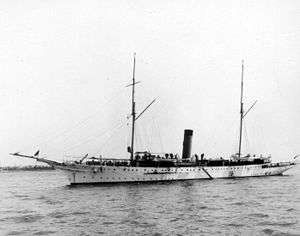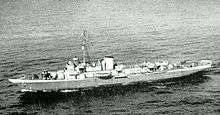USS Mayflower (PY-1)
 USS Mayflower | |
| History | |
|---|---|
| Name: | USS Mayflower |
| Builder: | J & G Thomson, Clydebank, Scotland |
| Launched: | 1896 |
| Acquired: | by purchase 1898 |
| Commissioned: | 24 March 1898 |
| Decommissioned: | 1 November 1904 |
| Recommissioned: | 25 July 1905 |
| Decommissioned: | 22 March 1929 |
| Fate: | Sold to private ownership, 19 October 1931 |
| Name: | USS Butte |
| Acquired: | by purchase, 31 July 1942 |
| Fate: | Transferred to the Coast Guard, 6 September 1943 |
| Name: | USCG Mayflower |
| Commissioned: | 19 October 1943 |
| Decommissioned: | 1 July 1946 |
| Fate: | Sold, 8 January 1947 |
| General characteristics (in US Navy service) | |
| Displacement: | 2,690 long tons (2,730 t) |
| Length: | 273 ft (83 m) |
| Beam: | 36 ft (11 m) |
| Draft: | 17 ft 2.5 in (5.245 m) |
| Speed: | 17 kn (20 mph; 31 km/h) |
| Complement: | 171 |
| Armament: | 6 × 6-pounder guns |
USS Mayflower (PY-1) (later as USCGC Mayflower (WPG-183)) was the second ship in the United States Navy to have that name. Mayflower—a luxurious steam yacht built in 1896 by J. and G. Thompson, Clydebank, Scotland for millionaire Ogden Goelet who died on board the Mayflower in August 1897.
Spanish–American War
With the Spanish–American War requiring that the Navy expand rapidly, she was purchased by the Navy from Goelet's estate and commissioned at the New York Navy Yard as the USS Mayflower on 24 March 1898 with Commander M. R. S. McKensie in command.
The Mayflower joined Admiral William T. Sampson's squadron at Key West, Florida on 20 April. Two days later, the squadron sailed to blockade Havana, Cuba. En route, Mayflower captured the Spanish schooner Santiago Apostol. She also took a number of fishing boats and coastal trading vessels. On 11 May, she boarded a large British merchant steamer, which also carried the name Mayflower, and sent the blockade runner to the United States under a prize crew. On the 14th, Alfonso led two Spanish gunboats out of the harbor hoping to break through the American blockade. Mayflower's guns engaged the Spanish warships and drove them back to shelter under the guns of Morro Castle. For the rest of the war, Mayflower guarded the ports of Santiago de Cuba and Cienfuegos.
Caribbean
Early in 1899, the yacht steamed to New York where she decommissioned on 2 February to be fitted out for special service in Puerto Rican waters. She recommissioned on 15 June 1900, with Commodore Duncan Kennedy in command. At San Juan, she served as headquarters for the government of the island being formed by the first American Governor Charles H. Allen.
In 1902, Mayflower twice served as Admiral George Dewey's flagship. In November 1903, Rear Admiral Joseph Coghlan flew his flag when off Panama during the revolution which established Panamanian independence and pointed toward the construction of the Panama Canal. She sailed to Europe in the summer of 1904, and in the fall carried Secretary of War William Howard Taft on an inspection tour of the West Indies. Mayflower was decommissioned at New York on 1 November 1904 for conversion to a presidential yacht.
Presidential yacht
Recommissioned on 25 July 1905, with Commander Cameron Winslow in command, she immediately sailed for Oyster Bay, Long Island, New York, to prepare for the peace conference which ended the Russo-Japanese War. President Roosevelt introduced the Russian and Japanese delegations on board Mayflower on 5 August. The ship continued to play a prominent role in support of the negotiations which won President Roosevelt the Nobel Peace Prize.
After duty as a dispatch boat protecting American interests in Santo Domingo in 1906, Mayflower served as presidential yacht until 1929. She was the scene of many diplomatic and social events during these years. Many members of the world's royal families visited the yacht and numerous persons of great prominence signed her guestbook. President Wilson selected Mayflower as the setting for much of his courtship of Mrs. Edith Bolling Galt.
One of Herbert Hoover's early acts as president was to dispense with Mayflower as an economy measure, saving upkeep costs of $300,000 per year. She was decommissioned at Philadelphia Navy Yard on 22 March 1929, and her Filipino crew was transferred to the presidential retreat at Rapidan Camp.[1] Placed up for auction, there were no bidders, and the ship was recommissioned for military use. During this overhaul at the Philadelphia Navy Yard, an intense fire broke out on 24 January 1931. So much water was pumped into her, that she sank and had to be raised.
In private ownership
The yacht was sold on 19 October 1931 to Leo P. Coe, agent for Frank P. Parish, a wealthy financier known as "The boy wizard of LaSalle Street" (Chicago's Wall Street). The following year while he was having the ship restored to her original luxurious splendor, by Henry J. Gielow Inc., of New York City, Parish's fortunes turned forcing him to sell the yacht shortly before he fled from the country to escape from prosecution and elude irate investors. During the depression years, a number of successive owners tried to promote a wide variety of projects for the ship, including use in the South America coastal trade, restoration as a historic relic, use as a floating dance salon, and even sale to the Japanese Government to be scrapped as Japan sought still to strengthen her war machine. However, a complex web of legal difficulties, a shortage of money, and marginal business conditions frustrated these enterprises while the ship idled in Atlantic ports from New York to Jacksonville, Florida, awaiting an opportunity for future service.
World War II


After America entered World War II, the War Shipping Administration purchased Mayflower from Broadfoot Iron Works Inc., Wilmington, North Carolina, on 31 July 1942 and renamed her USS Butte. Transferred to the Coast Guard on 6 September 1943, the ship was recommissioned as USCGC Mayflower (WPE-183) on 19 October 1943. She patrolled the Atlantic coast guarding against German U-boats and escorted coastal shipping besides serving as a radar training ship at Norfolk and Boston.
End of career
Decommissioned on 1 July 1946, Mayflower was sold at Baltimore to Frank M. Shaw on 8 January 1947 for use in the Arctic as a sealer. However, while sailing for sealing waters between Greenland and Labrador, early in March, Mayflower was damaged by fire off Point Lookout and forced to return to Baltimore. Collins Distributors Inc., purchased the ship early in 1948, installed new boilers in her at New York, and documented her as Malla under the Panamanian flag. She was subsequently fitted out at Genoa, Italy, ostensibly for coastwise trade in the Mediterranean. After sailing secretly from Marseilles, she arrived at Haifa in Israel on 3 September. On board were Jewish refugees. Most were former passengers of the ill-fated Exodus which had been turned back from Palestine the previous summer.
Legacy
The Mayflower had one of the most diverse and interesting "lives" of any ship in history. She served as the presidential yacht for five United States presidents (T. Roosevelt, Taft, Wilson, Harding, Coolidge). She also served as a warship, and was possibly the only US Navy ship (certainly one of the very few) to have been in active commissioned service in the Spanish-American War, World War I and World War II. She was also one of the few ships to have served in both the United States and Israeli navies.
Awards
- Sampson Medal (1898)
- Spanish Campaign Medal (1898)
- World War I Victory Medal (1917–1919)
- American Campaign Medal (1942–1946)
- World War II Victory Medal (1942–1946)
References
- This article incorporates text from the public domain Dictionary of American Naval Fighting Ships. The entry can be found here.
- "A Tour for Docents of The Presidential Yacht Potomac" (PDF). The Potomac Association. Retrieved 2013-01-06.
External links
| Wikimedia Commons has media related to USS Mayflower (PY-1). |
- Speaking of Pictures ... These Show the Life & Times of Famous U.S.S. Mayflower—LIFE Oct 11, 1943
- navsource.org: USS Mayflower
- hazegray.org: USS Mayflower
- Naval Historical Center: USS Mayflower